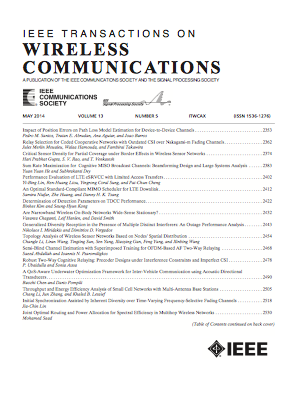Resource Allocation Exploiting Reflective Surfaces to Minimize the Outage Probability in VLC
IF 10.7
1区 计算机科学
Q1 ENGINEERING, ELECTRICAL & ELECTRONIC
引用次数: 0
Abstract
Visible light communication (VLC) is a technology that complements radio frequency (RF) to fulfill the ever-increasing demand for wireless data traffic. The ubiquity of light-emitting diodes (LEDs), exploited as transmitters, increases the VLC market penetration and positions it as one of the most promising technologies to alleviate the spectrum scarcity of RF. However, VLC deployment is hindered by blockage causing connectivity outages in the presence of obstacles. Recently, optical reconfigurable intelligent surfaces (ORISs) have been considered to mitigate this problem. While prior works exploit ORISs for data or secrecy rate maximization, this paper studies the optimal placement of mirrors and ORISs, and the LED power allocation, for jointly minimizing the outage probability while keeping the lighting standards. We describe an optimal outage minimization framework called JointMinOut and present solvable heuristics. We provide extensive numerical results and show that the use of ORISs may reduce the outage probability by up to 67% with respect to a no-mirror scenario and provide a gain of hundreds of kbit/J in optical energy efficiency with respect to the presented benchmark.利用反射面进行资源分配以最小化VLC中的中断概率
可见光通信(VLC)是一种补充射频(RF)的技术,以满足不断增长的无线数据流量需求。作为发射器的发光二极管(led)无处不在,增加了VLC市场渗透率,并使其成为缓解射频频谱稀缺的最有前途的技术之一。然而,在障碍物存在的情况下,阻塞导致连接中断,阻碍了VLC的部署。最近,光学可重构智能表面(ORISs)被认为可以缓解这一问题。先前的工作利用oris来实现数据或保密率最大化,而本文研究了反射镜和oris的最佳放置以及LED功率分配,以在保持照明标准的同时最大限度地降低停电概率。我们描述了一个称为JointMinOut的最优停机最小化框架,并提出了可求解的启发式方法。我们提供了广泛的数值结果,并表明ORISs的使用可以将中断概率降低高达67%,并且相对于所提供的基准,可以提供数百kbit/J的光能效率增益。
本文章由计算机程序翻译,如有差异,请以英文原文为准。
求助全文
约1分钟内获得全文
求助全文
来源期刊
CiteScore
18.60
自引率
10.60%
发文量
708
审稿时长
5.6 months
期刊介绍:
The IEEE Transactions on Wireless Communications is a prestigious publication that showcases cutting-edge advancements in wireless communications. It welcomes both theoretical and practical contributions in various areas. The scope of the Transactions encompasses a wide range of topics, including modulation and coding, detection and estimation, propagation and channel characterization, and diversity techniques. The journal also emphasizes the physical and link layer communication aspects of network architectures and protocols.
The journal is open to papers on specific topics or non-traditional topics related to specific application areas. This includes simulation tools and methodologies, orthogonal frequency division multiplexing, MIMO systems, and wireless over optical technologies.
Overall, the IEEE Transactions on Wireless Communications serves as a platform for high-quality manuscripts that push the boundaries of wireless communications and contribute to advancements in the field.

 求助内容:
求助内容: 应助结果提醒方式:
应助结果提醒方式:


